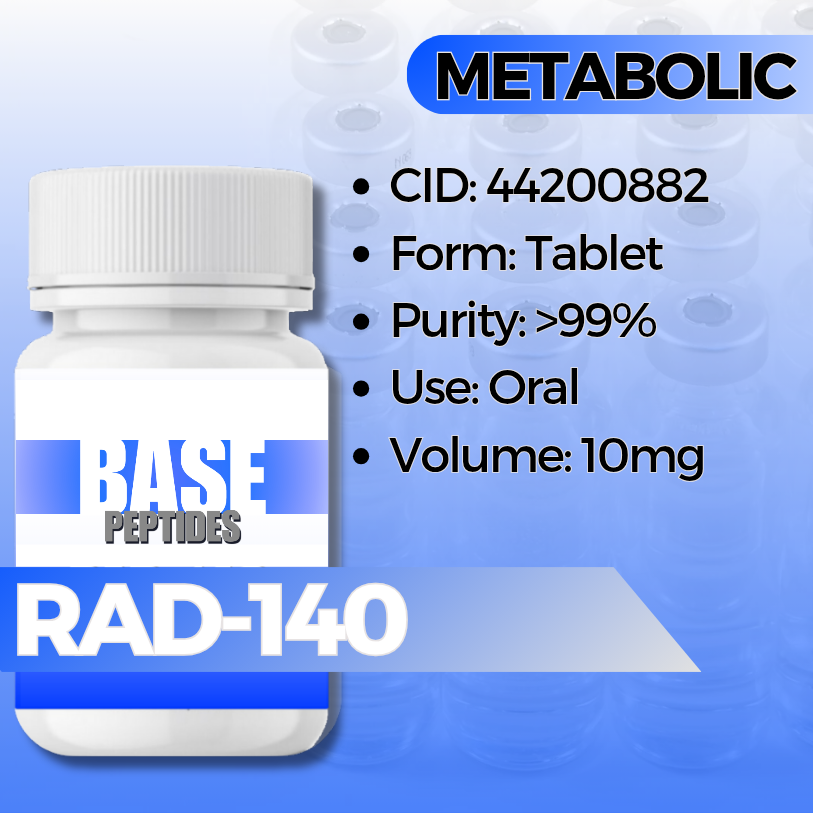RAD
RAD
Base Peptides are intended for licensed medical professionals and experienced researchers. Reconstitution required. Dosing and use instructions are not provided.
Regular price
$140.00
Regular price
Sale price
$140.00
Shipping calculated at checkout.
Quantity
Couldn't load pickup availability
RAD140 (Testolone) — Selective Androgen Receptor Modulator (SARM)
RAD140—also known as Vosilasarm / EP0062—is an orally active, non-steroidal selective androgen receptor modulator (SARM) used in research on muscle & bone biology, neuroprotection, and androgen-receptor–positive oncology.
Identifiers
- Synonyms: RAD140; Testolone; Vosilasarm; EP0062
- CAS No.: 1182367-47-0
- Molecular Formula: C20H16ClN5O2 • MW: ~393.8 g·mol⁻¹
- Class: Non-steroidal AR agonist / SARM (oral)
- Reported t1/2 (models): ~45–60 h (literature reports; study-dependent)
How It Works (Plain English)
- Binds the androgen receptor (AR) with tissue selectivity, promoting anabolic signaling in muscle and bone while aiming to limit classic androgenic effects in other tissues.
- In neural models, AR activation by RAD140 showed neuroprotective effects against apoptotic stressors.
- In AR-positive breast-cancer models, RAD140 acted as a selective AR agonist with AR-mediated repression of ER pathways (distinct from testosterone/androgens).
Why Researchers Use It
- Probe skeletal muscle hypertrophy, protein turnover, and bone markers in preclinical systems.
- Interrogate neuron survival/stress-resistance pathways via AR signaling.
- Evaluate AR-positive, ER-negative oncology mechanisms and AR-ER crosstalk.
Key Study Themes — What Was Tested, What Changed, Why It Matters
Neuroprotection (in vitro & rodent)
- What was tested: Cultured hippocampal neurons and kainate-lesioned rats exposed to RAD140 vs testosterone.
- What changed: RAD140 was as effective as testosterone in reducing apoptotic cell death; supported neuronal survival in vivo.
- Why it matters: Highlights AR-driven protective signaling in neural tissue beyond classic anabolic targets.
AR-Positive Breast Cancer (translational)
- What was tested: AR-positive breast-cancer cell and xenograft models; early-phase human trials have explored safety/pharmacology.
- What changed: RAD140 showed potent AR agonism and AR-mediated repression of ESR1/ER signaling in preclinical work; Phase 1 first-in-human study reported feasibility and characterized exposure/safety.
- Why it matters: Provides a research path for AR-targeted strategies distinct from steroidal androgens.
Muscle & Functional Outcomes (preclinical)
- What was tested: Rodent models assessing hypertrophy/overload, frailty indices, grip strength, and recovery with SARM exposure.
- What changed: Studies report anabolic/functional effects that are design-dependent (some mixed findings in aging models).
- Why it matters: Useful comparator for SARMs vs GH/IGF-axis interventions.
Potential Research Applications
Muscle & Bone Biology
- Myotube protein synthesis, muscle CSA, bone-turnover markers
Neurobiology
- Apoptosis resistance, neurite integrity, stress-response panels
Oncology (AR-Positive)
- AR agonism, AR–ER crosstalk, growth/response signatures
Synergistic / Comparator Agents
MK-677 (GHSR-1a agonist)
- Why compare: GH/IGF-1–axis vs direct AR agonism for anabolic endpoints.
Tesamorelin / CJC-1295+Ipamorelin
- Why pair/compare: Pituitary-driven endocrine strategies vs SARM receptor-level signaling.
Ostarine / LGD-4033 (comparators)
- Why compare: Benchmark anabolic selectivity and safety panels across SARM classes.
Known Concerns (Context)
- Regulatory status: Investigational; not an approved therapeutic indication in many jurisdictions.
- Liver & cardio panels: Case reports link black-market SARM products to drug-induced liver injury; ensure rigorous QC and model-appropriate monitoring.
- Endocrine feedback: AR-pathway agents may influence endogenous hormone axes; include comprehensive panels where relevant.
- General: For laboratory research use only; not for human consumption or veterinary/medical use.
Specifications & Handling
- Form: Small-molecule solid (lot-coded)
- Purity: Research-grade (HPLC/MS)
- Storage: Cool, dry; protect from light/moisture
- In solution: Soluble in DMSO/ethanol—document solvent %, pH, and time-to-assay; minimize freeze–thaw
- Labeling: Tamper-evident; CAS/lot/SKU clearly displayed; “research use only”
Regulatory & Use Notice
Sold for laboratory research use only. Not for human consumption, medical, or veterinary use. No human-use instructions are provided. Buyer is responsible for safe handling and regulatory compliance.
RAD140 (Testolone) Research Compound | Selective Androgen Receptor Modulator | Muscle, Neuroprotection & AR-Positive Oncology Studies


